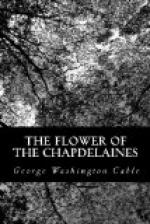But this Sunday promised unusual pleasure. I was to go with Aunt Marion to dine soon after midday with a Danish family, in real Danish West Indian fashion, and among the guests were to be some officers of the East-Indiamen. I carried with me one fear—that we should have pigeon-pea soup. Whoever ate pigeon-pea soup, Si’ Myra said, would never want to leave the island, and I longed for those ships to go. But in due time we were asked:
“Which soup will you have—guava-berry or pigeon-pea?”
Hoping to be imitated I chose the guava-berry; but without any immediately visible effect one officer took one and another the other. After soup came an elegant kingfish, and by and by the famous callalou and other delicate and curious viands. For dessert appeared “red groat”; sago jelly, that is, flavored with guavas, crimsoned with the juice of the prickly-pear and floating in milk; also other floating islands of guava jelly beaten with eggs. Pale-green granadillas crowned the feast. These were eaten with sugar and wine, and before each draft the men lifted their glasses high to right and left and cried: “Skoal! Skoal!” As the company finally rose, our host and hostess shook hands with all, these again saluting each other, each two saying: “Vel be komme”—“May this feast do you good.”
There was strange contrast in store for us. Late in the afternoon we started home. On the way two friends, a lady and her daughter, persuaded us to turn and take a walk on the north-side road, at the town’s western border. It drew us southward toward “the lagoon,” near to where this water formed a kind of moat behind the fort, and was spanned by a slight wooden bridge. While we went the sun slowly sank through a golden light toward the purple sea, among temples, towers, and altars of cloud.
As we neared this bridge two black men crossing it from opposite ways stopped and spoke low:
“Yes, me yerry it; dem say sich t’ing’ as nebber bin known befo’ goin’ be done in West-En’ town to-night.”
“Well, you look sharp, me frien’——”
Seeing us, they parted abruptly, one troubled, the other pleased and brisk. Our friends drew back: “What does he mean, mother?”
“Oh, some meeting to make Christmas songs, I suppose.”
“I think not,” said Aunt Marion. “Let’s go back; my mother’s alone.”
Just then Gilbert, young son of an intimate neighbor, appeared, saying to the four of us: “I’ve come to find you and see you home. The thing’s on us. The slaves rise to-night. Some free negroes have betrayed them. At eight o’clock they, the slaves, are to attack the town.”
Our home was reached first. Grandmamma heard the news calmly. “We’re in God’s hands,” she said. “Gilbert, will you stop at Mr. Kenyon’s” [another neighbor] “and send Anna and Marcia home?”
Mr. Kenyon came bringing them and begging that we all go and pass the night with him. But grandmamma thought we had better stay home, and he went away to propose to the neighborhood that all the women and children be put into the fort, that the men might be the freer to defend them.




